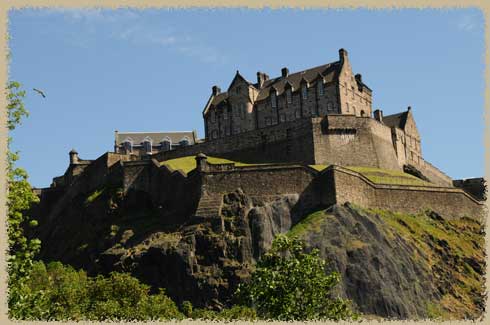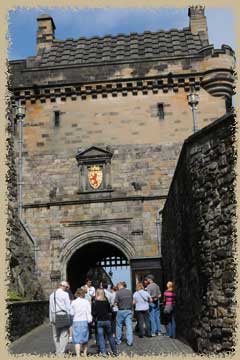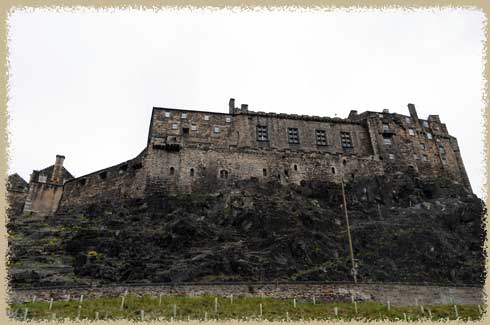Edinburgh Castle

from Princes Street, looking up Castle Rock
Ancient fortress
The volcanic hill in the center of Edinburgh has been the site of a fortress since the Bronze Age or earlier-- it commanded the landscape for miles, and was an obvious choice for a site. Steep cliffs protect three sides of any fortification here, and a steep, narrow pathway up to the castle gates is easily defended.
Early scottish kings would have taken over this hill and built a variety of fortrsses on it, probably early timber castles that are long gone. The castle has been used a site for the royal treasury since this time.
Later Castles
 the main gate
the main gate
The earliest stone ruins on the hilltop date from the 12th century - a small norman chapel dedicated to St Margaret (she died in 1093 a few days after her husband, Malcom Canmore died at Alnwick Castle). The castle was besieged immediately upon their deaths by his brother, in a claim for the throne of Scotland. The castle was surrendered to the English in 1173, but was --as usual--later recovered by the Scots.
All of the castle defenses and walls were destroyed by King Robert in 1313, leaving only St. Margaret's Chapel and the large constables tower on the hill.
In 1371, King David II rebuilt the castle witn curtain walls and towers, including the large L-plan tower house on the site caleld David's Tower. The tower has been mostly incorporated into later work - it is almost entirley surrounded by later stone walls and is encased in the half-moon battery, added after the castle was severely damaged by artillery after 1573.
A new hall was added 1483, and a new royal palace was added for James V.However,, the nearby Holyrood Palace was viewed as amuch more comfortable royal residence, and the castle was used less and less as a royal abode. Most of the current castle dates from the 17th and 18th centuries, when Charles II added new work to the forticiations, and it was upgraded and expanded to defend against artillery.
The castle today
The wide esplanade -- now a perfect place for parades and concerts -- is the only access to the castle, and is protected bya wide ditch and a massive gatehouse added in 1887. The main path through the castle leads around to the Portcullis gate (from the 1570s) that lies on the site of the 14th century Constables tower.

looking up at the curtain wall
The Half-Moon Battery overlooks Edinburgh (and the views are stunning on a clear day). It waa dded in the late 16th century over the top of the David's tower, entirely encasing the lower story inside the stone. The tower still stands two storeys high (out of five). It was originaly a large L-plan tower (15.4m x 11.5m with a 6.3m wing), alhtougn it was later filled in to make a nearly sqaure tower.

